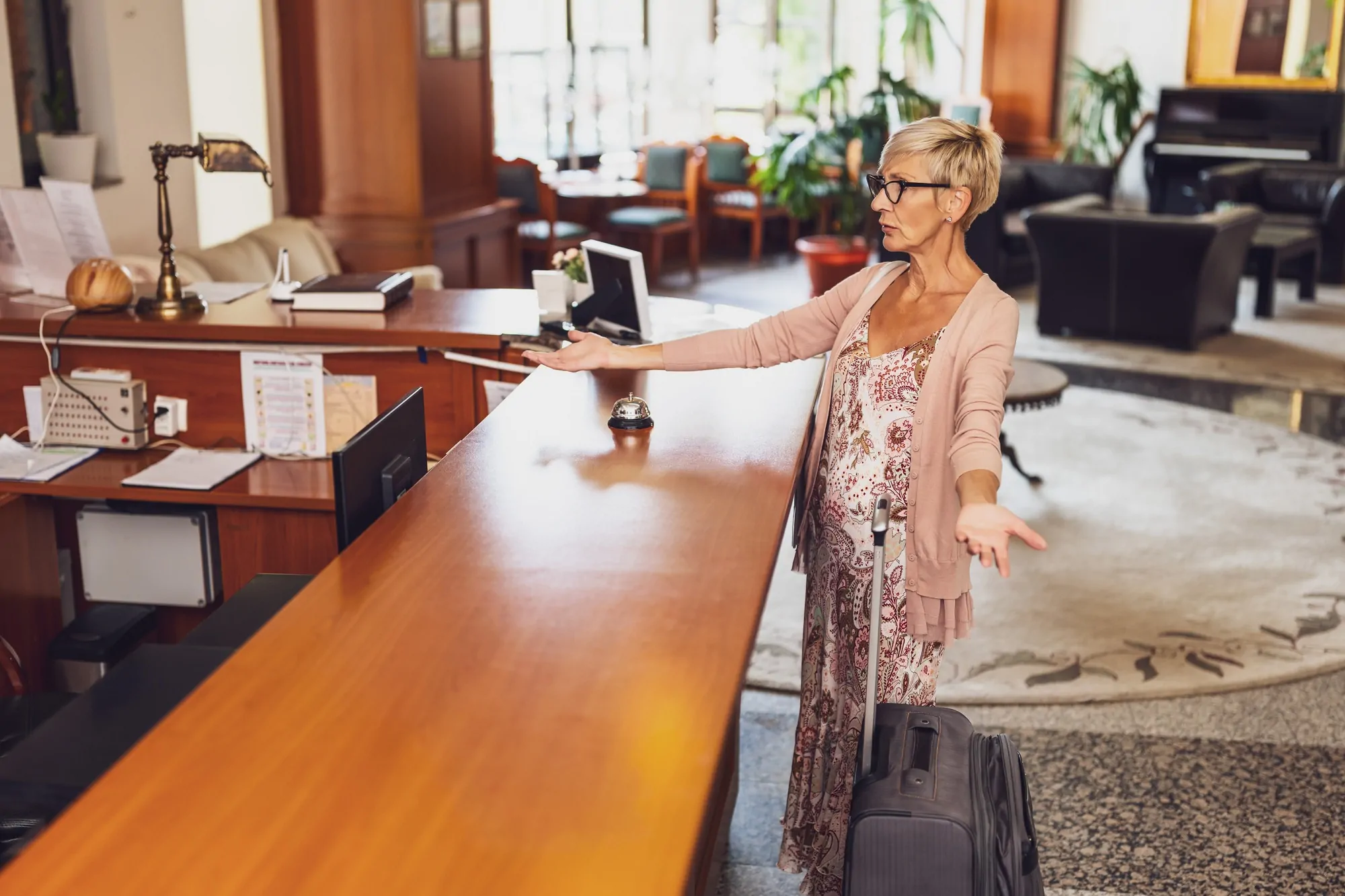
Thinking About a Check‑in Kiosk? Read This Before You Replace Your Front Desk.
Table of Contents
ToggleKiosk vendors promise faster lines and lower labor costs. But most brands still require a team member at the desk at all times, and guests are pushing back on kiosk‑only check‑ins—especially at night. If you want speed without sacrificing standards or safety, consider pairing your staffed desk with Guest Ban ID Scanning to automate ID capture, auto‑fill the PMS, and strengthen security. Here’s how to stay on brand, protect safety, and avoid a PR storm.
1) Brand standards & approvals
Bottom line: For many major flags, kiosks can supplement—not replace—the front desk. Brand standards typically expect a trained team member to be physically stationed at the desk at all times. Always obtain written approval from your brand before adding a kiosk or changing overnight staffing.
Recent viral examples show the reputational risk of ignoring this. A franchised property that used a virtual, remote “front desk” via a lobby screen triggered national coverage and public criticism; the parent brand clarified the equipment was not brand‑approved and reiterated the requirement to keep a team member at the desk. If you’re considering kiosk‑only operations, talk to your brand first and get guidance in writing.
2) Why nights are different (risk checklist)
Most serious incidents happen after dark. Overnight staffing is not just about handing out keys—it’s about safety, rapid response, and duty of care. Night coverage typically includes:
- Emergency response: fire alarms, medical incidents, severe weather, evacuations, elevator entrapments.
- Security rounds: parking lots, stairwells, back‑of‑house, pool closure checks, doors & access control.
- Law‑enforcement coordination: calling police, taking statements, preserving footage, trespass enforcement.
- Guest issues: noise complaints, domestic disputes, intoxication, welfare checks, lockouts, lost children.
- Fraud prevention: ID checks, payment verification, chargeback evidence capture, DNR enforcement.
- Facilities: floods/leaks, power or HVAC failures, boiler/chiller alarms, freezer/IT room alarms, water shut‑offs.
- Vendor & delivery management: late arrivals, tow/boot requests, taxi/rideshare issues.
- Human‑trafficking awareness and incident escalation per brand and industry guidance.
If no one is physically present, response times stretch and liability rises.
Miami hotel has outsourced their front desk to India. Guests are checked in virtually on video call with an Indian representative
More American jobs outsourced overseas. At some point this should just become illegal. If you make money in America, you should hire Americans pic.twitter.com/la8FJZHym3
— Wall Street Apes (@WallStreetApes) August 2, 2025
3) What guests are saying: backlash & trust
What guests & staff complain about (paraphrased)
- Safety perception: “No one is here at 1–3AM; if something happens, who responds?”
- Outsourcing backlash: Remote/overseas attendants feel impersonal; some guests see it as cutting local jobs.
- Escalation gaps: A screen can’t walk the property, de‑escalate noise disputes, or assist vulnerable guests.
- Glitches & lockouts: When kiosks hang, travelers are stranded in the lobby with luggage at night.
- Accessibility & language: Limited ADA support, small fonts, or accents create stress without on‑site help.
- Privacy concerns: Guests dislike entering PII at an unattended screen; shoulder‑surfing risks increase.
- Key control: Unsupervised key issuance increases the chance of the wrong person accessing a room.
- Service quality: Special requests, billing fixes, or local guidance are slower through a kiosk.
This sentiment shows up repeatedly across social posts and comment threads when hotels try kiosk‑only overnight.
4) Cost & ROI: Are kiosks truly cheaper?
Reality check: If your brand still requires a team member on site 24/7, then paying for a kiosk plus staffing often increases costs—not decreases them. You may end up paying more for the same coverage. In other words, you could be paying twice: a kiosk subscription and on‑site labor.
Questions to ask before you buy
- Does our flag permit kiosk‑only hours? If not, what’s the ROI with full staffing?
- What incidents will still require a person on site (most of them)?
- What measurable savings are expected beyond peak‑time line relief?
- How will we handle failures, fraud, and accessibility without delaying guests?
These are all items to consider before committing budget to a kiosk program.
5) Alternative: Guest Ban ID Scanning
When you must keep a person at the desk anyway, consider upgrading the desk instead of replacing it. Guest Ban automates the slow parts of check‑in while improving security:
- Speed: Scan government ID → auto‑fill PMS fields (no typing), print key, move on. Lines shrink without removing staff.
- Security: Real‑time DNR checks and secure ID proof help prevent problem‑guest incidents and win chargebacks.
- Workload reduction: Fewer manual entries and fewer mistakes; staff stay available for escalations and rounds.
- Guest trust: Guests see a human responsible for safety while enjoying a faster, more accurate check‑in.
- Cost control: No kiosk hardware to maintain; you aren’t paying for a kiosk and overnight staffing.
One GM told us they’re not sure if the staff is lazy or just spoiled now—they can’t live without the auto‑fill feature anymore.
6) Risks of kiosk‑only operations
Risks of kiosk‑only operations
- Brand non‑compliance: Loss of flag or required remediation if standards mandate a staffed desk 24/7.
- Safety & liability: Delayed emergency response; weaker incident documentation; higher exposure.
- Fraud & chargebacks: Lower‑quality ID verification at unattended kiosks; fewer controls on shared keys.
- Reputation damage: Viral backlash and negative reviews suggesting the hotel is “unmanned.”
- Accessibility gaps: Kiosk outages, language support, and ADA/Wayfinding issues without on‑site help.
Where kiosks help (when used correctly)
- Peak‑time overflow to shorten lines.
- Late arrivals when a staffed desk is busy.
- Simple transactions: digital keys, receipts, folios.
- Pre‑registered guests who still need on‑site support.
7) A better model: Staffed desk + tech
Keep a live front desk
Maintain on‑site coverage 24/7. For limited‑service hotels, cross‑train night staff to handle safety checks, light maintenance triage, guest issues, and incident reporting.
Use kiosks as a supplement
Deploy kiosks for overflow—never as your only option. Add clear signage that a team member is on site and available immediately when needed.
Strengthen ID & payments
Pair check‑in with Guest Ban ID Scanning—ID scanning → PMS auto‑fill → DNR checks → secure ID proof—to speed up check‑ins, enhance security, and reduce front‑desk workload. Require manual review for mismatches or high‑risk profiles.
Plan for the 1% moments
Write a night‑shift playbook: emergency tree, police liaison, incident forms, camera retention, panic‑button use, and after‑action reviews. Drill quarterly.
8) Pre‑deployment checklist
- Confirm brand approval in writing for kiosks and any changes to overnight staffing.
- Publish an overnight staffing plan (coverage, breaks, cross‑training, escalation).
- Define security rounds and documentation with time‑stamped logs.
- Install ID verification with DNR checks and secure storage of ID proof.
- Validate ADA accessibility and multi‑language support at kiosks.
- Harden key control: no unattended keycard stacks; require identity verification.
- Test failover: if the kiosk or network dies, guests still get service instantly.
- Prepare a communications plan for guests and media (what you use, why, and how you ensure safety).
9) FAQs
“We’re short‑staffed. Can a kiosk cover us at night?”
Use kiosks to relieve pressure, not to replace people. Nights carry higher risk. Keep a trained employee on site and visible—your duty of care, guest trust, and brand relationship depend on it.
“Guests like the speed of kiosks. Isn’t that enough?”
Speed matters at 6pm. At 2am, safety matters more. Combine convenience with on‑site staff, clear signage, and escalation paths so guests never feel abandoned.
“What about remote/outsourced attendants on a screen?”
Even if legally permissible, remote‑only coverage can violate brand standards and can trigger local backlash. If you pilot remote assist, keep on‑site staff and make sure it’s brand‑approved first.
